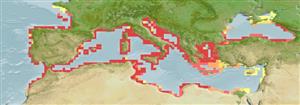Actinopterygii (ray-finned fishes) >
Perciformes (Perch-likes) >
Labridae (Wrasses)
Etymology: Symphodus: Greek, syn, symphysis = grown together + Greek, odous = teeth (Ref. 45335).
Environment / Climate / Range
Ecology
Marine; brackish; reef-associated; depth range 1 - 30 m (Ref. 4742). Subtropical, preferred ?; 48°N - 30°N, 10°W - 42°E
Eastern Atlantic: Gulf of Gascogne to Gibraltar including the Mediterranean and Black Sea.
Length at first maturity / Size / Weight / Age
Maturity: Lm ?, range 5 - 7 cm
Max length : 17.0 cm SL male/unsexed; (Ref. 4742); common length : 12.0 cm SL male/unsexed; (Ref. 4742); max. reported age: 8 years (Ref. 4742)
Adults are found near rocks, mainly in eel-grass beds (Ref. 4742). Mainly solitary (Ref. 4742). Nest of seaweed built by male (Ref. 4742). Feed on mollusks, bivalves, gastropods, shrimps, sea-urchins and hydroids (Ref. 4742). Males grow faster than females (Ref. 4742). Oviparous, distinct pairing during breeding (Ref. 205).
Oviparous, distinct pairing during breeding (Ref. 205). Each male builds a nest of seaweed for one or two females to spawn in (Ref. 4742).
Quignard, J.-P. and A. Pras, 1986. Labridae. p. 919-942. In P.J.P. Whitehead, M.-L. Bauchot, J.-C. Hureau, J. Nielsen and E. Tortonese (eds.) Fishes of the north-eastern Atlantic and the Mediterranean. UNESCO, Paris. Vol. 2. (Ref. 4742)
IUCN Red List Status (Ref. 115185)
CITES (Ref. 94142)
Not Evaluated
Threat to humans
Harmless
Human uses
Fisheries: subsistence fisheries; aquarium: commercial
More information
ReferencesAquacultureAquaculture profileStrainsGeneticsAllele frequenciesHeritabilityDiseasesProcessingMass conversion
Tools
Special reports
Download XML
Internet sources
